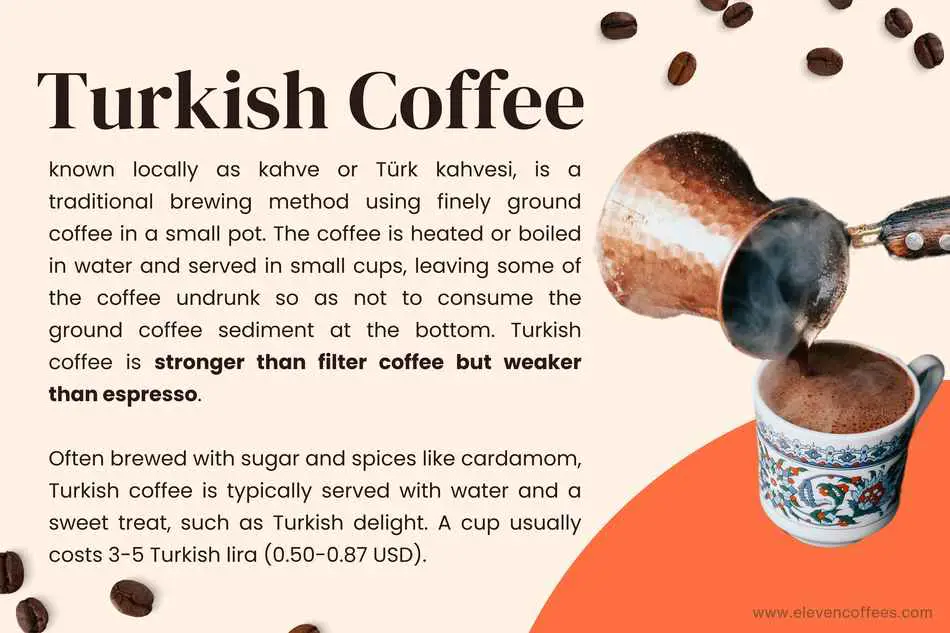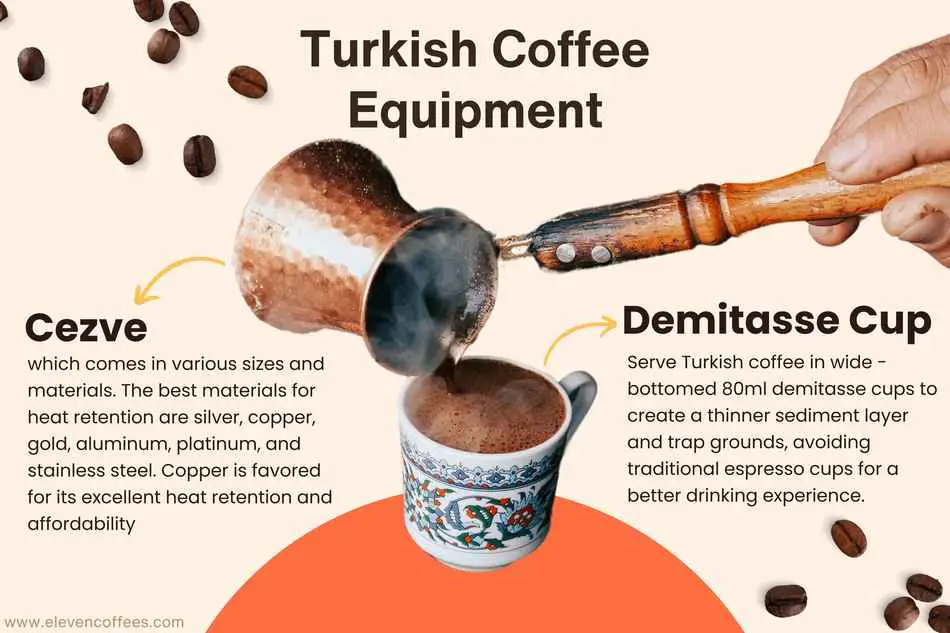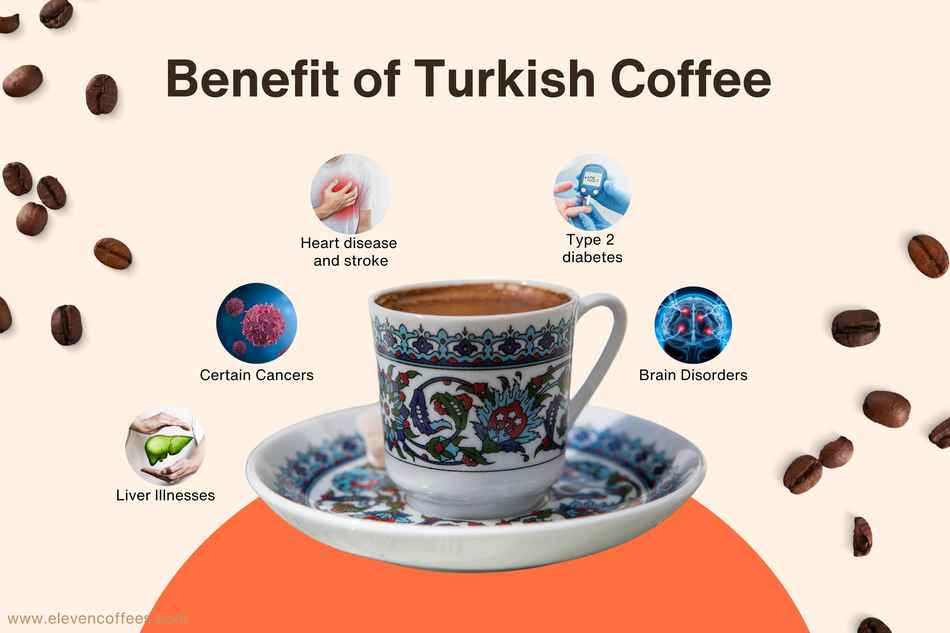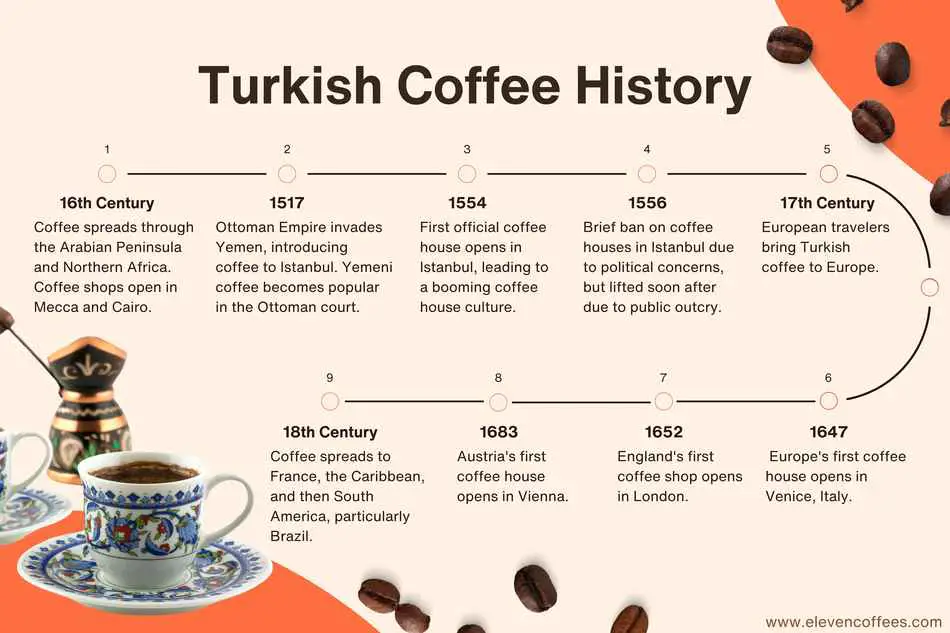The Complete Guide to Turkish Coffee in 2025
Are you planning a trip to Turkey and want to know more about traditional Turkish coffee? Or perhaps you’ve just come back and want to prepare yourself a cup at home. We’ve got it all covered in our guide to Turkish coffee here.
Turkish coffee is a coffee-brewing method. The process begins by mixing finely ground coffee beans with water inside a cezve (ibrik). The coffee is brought to a boil over a gas flame and can be cooled up to three times to create foam. Finally, the cezve empties its contents unfiltered into a demitasse cup, ready to be enjoyed.
For many, Turkish coffee is shrouded in mystery. Here, we delve into this historical brewing preparation so you can try it yourself.
What is Turkish coffee?

Turkish coffee refers to a preparation method used throughout Turkey and neighboring countries. Locally, people call it kahve or Türk kahvesi in Turkey.
It’s not a type of coffee bean but a preparation method for brewing coffee. People recorded it as one of the earliest ways to prepare coffee.
The process of brewing coffee this way is called decoction. Decoction is heating or boiling a substance in a liquid[1].
Brewers prepare Turkish coffee in a cezve (pronounced jehz-veh) using extremely finely ground coffee. A cezve is a small pot with a long handle and a pouring lip. People often refer to cezves as ibriks, using the terms interchangeably outside of Turkey.
Servers present the coffee in very small cups, with a typical serving containing around 60 ml of liquid coffee. Drinkers consume it in four to five sips, leaving some coffee undrunk to avoid the ground coffee sediment at the bottom.
Turkish coffee is stronger than regular filter coffee but weaker than espresso.
- Turkish coffee uses a brew ratio of around 10g of coffee per 100ml of water.
- Filter coffee uses around 6g of coffee per 100ml of water.
- Espresso coffee uses as much as 50g of coffee per 100ml of water.
Some brewers add sugar and spices like cardamom and clove to the coffee. Coffee houses often serve it on a tray with a small glass of water and a sweet treat, such as Turkish delight.
On average, a cup typically costs 3 – 5 Turkish lira (0.50 – 0.87 USD) in Turkey at the time of writing.
How is Turkish coffee prepared?
First, grind the coffee beans extremely finely. The grind is actually finer than for espresso and normally requires a hand grinder to achieve such fine particle size. Few electric grinders are capable of grinding fine enough for Turkish coffee due to clumping and clogging of the machine.
To prepare Turkish coffee, you usually add the ground coffee to an empty cezve, then pour in room-temperature water. Next, you typically place the cezve over a gas flame and heat it until it boils.
At this point, the coffee cools slightly before boiling again to create more foam. This process can repeat up to three times, depending on the preferences of the establishment or home drinker.
Once you prepare the coffee, you pour almost all the contents of the cezve unfiltered into a small cup called a demitasse.
Most of the coffee grounds settle at the bottom, forming a layer similar to the sediment found at the bottom of a cup of coffee made with a French press.
Since Turkish coffee doesn’t pass through cloth or paper filters, it provides a rich body and mouthfeel.

How to drink Turkish coffee
To drink the coffee properly, you must push any floating coffee gently downwards from the surface. You must never stir so as not to unsettle the coffee grounds at the bottom.
It’s important to wait around four minutes before drinking the coffee to allow it to cool enough to experience its flavours.
Many people who are not accustomed to drinking Turkish coffee consume it immediately after preparation. This results in the ingestion of the floating layer of coffee grounds and is very unpleasant.
Due to coffee grounds being in the cup, the coffee continues to extract due to thermodynamics (residual heat). It’s therefore important to drink the coffee within 10 minutes or so of preparation to avoid over-extraction (bitterness).
Turkish coffee often includes sugar to counteract bitterness, and it sometimes features spices like cardamom, cinnamon, and clove for added flavor.
To enjoy sweetened Turkish coffee, always add the sugar to the cezve during the preparation process. It’s not possible to add sugar later on in the cup as stirring to dissolve the sugar would whip up the unfiltered coffee grounds at the bottom, resulting in a very muddy brew.
Make sure to order your coffee with sugar if you want it sweetened. Keep reading to find out how to order Turkish coffee in Turkey like a local.

Turkish coffee equipment

You make Turkish coffee in a cezve, which is also known as a jezve or gezve. Cezves come in different sizes and it’s important to use the appropriate size for the number of cups that you want to make.
Cezves come in a variety of materials. Each material has its own thermal conductivity (heat retention).
Cezve heat retention from best to worst:
- Silver
- Copper
- Gold
- Aluminium
- Platinum
- Stainless steel.
Copper is the favourite of serious Turkish coffee drinkers as it’s almost as good as silver but around 10 times cheaper in price.
Turkish coffee is served in a demitasse (a small cup with a capacity of around 80ml) and saucer. Turgay Yildizli, the 2013 World Cezve/Ibrik Champion, recommends avoiding traditional espresso cups and, instead, using wide-bottomed demitasse cups.
The wider bottom serves to create a thinner layer of ground coffee sediment and also acts as a pocket to trap the coffee grounds when you drink from the cup.
This is a simple way to improve the drinking experience. For more ways to improve your coffee, check out our 50 tips.

How much caffeine is in Turkish coffee?
A typical cup of Turkish coffee contains 60mg of caffeine. Turkish coffee contains 84mg of caffeine per 100ml (25mg per fluid ounce). Here is a comparison guide with other caffeinated beverages:
| Beverage | Caffeine per 100ml (3.38fl oz) |
|---|---|
| Espresso | 180mg |
| Turkish coffee | 84mg |
| Filter coffee | 40mg |
| Red Bull | 32mg |
| Instant coffee | 26mg |
| Coca-Cola | 10mg |
Turkish coffee: arabica or robusta?
Turkish coffee is mostly made from 100% arabica coffee beans. This differs from neighbouring Greece where they drink the inferior robusta variety of coffee beans.
The Turkish prefer a very darkly roasted coffee as opposed to the lighter roasts favoured by the Greeks. Unfortunately, darkly roasted coffee adds to the bitterness found in Turkish coffee.
Turkish people use coffee beans sourced from all over the world as coffee does not grow in Turkey.
Is Turkish coffee good for you?

Turkish coffee has the same health benefits as any other black coffee. Drinking unsweetened Turkish coffee contains around 5 calories per cup.
Due to the bitterness of Turkish coffee, a lot of people drink it with sugar which adds to the calories. A typical serving of sweetened Turkish coffee contains around 11.5g of sugar which brings the overall calories to 46kcal per cup.
Benefits of drinking Turkish coffee include reduced risk of:
heart disease and stroke
certain cancers
liver illnesses, including non-alcoholic fatty liver disease, liver fibrosis, and liver cirrhosis
type 2 diabetes
brain disorders, such as depression, Alzheimer’s disease, and Parkinson’s disease
Source: Healthline.com
Do you drink the grounds in Turkish coffee?
No, leave the last few drops as drinking the ground coffee sediment is very unpleasant. However, if you do so by accident, it isn’t going to hurt you and could actually be beneficial to your health.
Researches at Vanderbilt University Center for Latin American Studies have recently discovered that spent coffee grounds are rich in vitamins, minerals, and antioxidants and are working on a method to extract these antioxidants to mix with our food.
But don’t go chomping down on vast quantities of your used coffee grounds just yet.
Some of the chemicals in coffee are potentially harmful. For example, coffee beans contain diterpene compounds, called cafestol and kahweol, which raise blood cholesterol.
These are removed by paper filters when coffee is brewed, but people who drink a lot of unfiltered coffee (such as Turkish, French press, and espresso) may see their cholesterol go up. If you eat the grounds, you’ll also get these compounds.
Source: Berkeley Wellness
Turkish coffee history

The rule of the Ottoman Empire has led to the preparation of coffee in this way for hundreds of years—not just in Turkey, but also throughout the Arabian Peninsula, the Middle East, Greece, the Balkans, and Northern Africa.
By way of Ethiopia and the Yemen, coffee made its way through the Arabian Peninsula and Northern Africa in the 16th-century with coffee shops opening in Mecca (Saudi Arabia) and Cairo (Egypt).
Since they couldn’t consume alcohol, men would gather at the mosque to enjoy caffeine’s effects.
In 1517, the Ottoman Empire invaded Yemen and brought coffee back to the sultans in Istanbul. The warm welcome led to the importation of Yemeni coffee that was ready-roasted.
The Ottomans later took charge of the trade of coffee in the Yemen so as not to lose control to other empires.
In 1554, two Syrian men opened the first official coffee house in Istanbul, sparking a booming coffee house culture.
However, just two years later, in 1556, authorities issued a ban on coffee houses due to fears that patrons might discuss plans to overthrow the Sultan. The uproar from the Turkish population quickly led to the ban’s reversal.
Did you know that history repeated itself exactly two centuries later in Sweden? You can read about it in another of my articles.
European travellers came across coffee in Turkey in the 17th-century and took it back to Europe.
This led to Europe’s first coffee house opening in Venice, Italy in 1647. Shortly after, England opened its first coffee shop in London in 1652, followed by Austria’s first coffee house in Vienna in 1683.
Coffee spread to France during this time as King Louis XIV of France was good friends with the Turkish Sultan Mehmet IV.
By way of the French, coffee found its way to the French-ruled Caribbean. From there it spread southwards to Brazil in the 18th-century and on to the rest of South America, causing it to become the coffee-producing behemoth that it is today.
The spread of coffee within the Ottoman Empire lead to countries serving their own take on Turkish coffee, with some even still referring to it as Turkish coffee in their own language.
How to order a coffee in Turkish
| English | Turkish | Pronunciation |
|---|---|---|
| Turkish coffee | Türk kahvesi | turk KAH-veh-see |
| without sugar | sade | sah-DEH |
| with a little sugar | az şekerli | AHZ sheh-kehr-lee |
| with medium sugar | orta şekerli | ohr-TAH sheh-kehr-lee |
| with lots of sugar | çok şekerli | CHOK sheh-kehr-lee |







